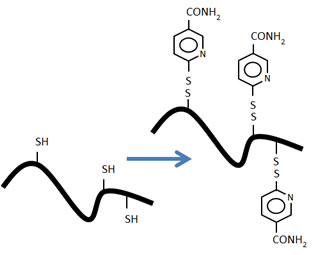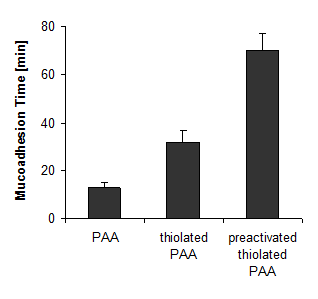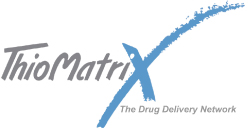|
| Events
Discovery & Development Europe 2025: Formulation & Drug Delivery Congress
July 1-2, 2025
Basel, Switzerland
Invited lecture:
Oral Delivery Of Peptide And Protein Drugs – Oral Delivery of GLP-1 Analogues
Prof. Dr. A. Bernkop-Schnürch
more...
8th European Cyclodextrin Conference
September 9-12, 2025
Milano, Italy
Invited lecture:
Thiolated Cyclodextrins in Drug Delivery
Prof. Dr. A. Bernkop-Schnürch
more...
|
|
 When even higher mucoadhesive properties are needed, thiomers can be preactivated by the covalent attachment of mercaptonicotinamide substructures via disulfide bonds. When even higher mucoadhesive properties are needed, thiomers can be preactivated by the covalent attachment of mercaptonicotinamide substructures via disulfide bonds.
 Mucoadhesive properties of polyacrylic acid (PAA) and thiolated polyacrylic acid (thiolated PAA), for instance, were strongly improved by preactivation (preactivated thiolated PAA) [Iqbal, J., Shahnaz, G., Dünnhaupt, S., Müller, C., Hintzen, F. and Bernkop-Schnürch, A. (2012) Preactivated thiomers as mucoadhesive polymers for drug delivery. Biomaterials, 33, 1528]. Furthermore, mucoadhesive properties of chitosan were 7-fold increased by thiolation and even 14-fold improved when this thiolated polymer was additionally preactivated [Dünnhaupt, S., Barthelmes, J., Thurner, C.C., Waldner, C., Sakloetsakun, D. and Bernkop-Schnürch A. (2012) S-protected thiolated chitosan: synthesis and in vitro characterization. Carbohydr. Polym., 90, 765]. Mucoadhesive properties of polyacrylic acid (PAA) and thiolated polyacrylic acid (thiolated PAA), for instance, were strongly improved by preactivation (preactivated thiolated PAA) [Iqbal, J., Shahnaz, G., Dünnhaupt, S., Müller, C., Hintzen, F. and Bernkop-Schnürch, A. (2012) Preactivated thiomers as mucoadhesive polymers for drug delivery. Biomaterials, 33, 1528]. Furthermore, mucoadhesive properties of chitosan were 7-fold increased by thiolation and even 14-fold improved when this thiolated polymer was additionally preactivated [Dünnhaupt, S., Barthelmes, J., Thurner, C.C., Waldner, C., Sakloetsakun, D. and Bernkop-Schnürch A. (2012) S-protected thiolated chitosan: synthesis and in vitro characterization. Carbohydr. Polym., 90, 765].
|
|
Mucoadhesion
As the uptake of most drugs from mucosal
membranes is controlled by a passive diffusion process, it is essential to
provide on the absorption membrane a concentration gradient as steep as
possible representing the driving force for drug absorption. In order to
achieve that goal the delivery system has to be kept as long as possible in
intimate contact with the absorption membrane, which can be guaranteed by
utilizing mucoadhesive drug delivery systems. The mucoadhesive properties of
all so far used polymers, however, are quite insufficient in order to
guarantee this effect. In contrast to these ‘conventional’ polymers,
whose mucoadhesive properties are exclusively based on non-covalent bonds,
thiolated polymers or designated thiomers are capable of forming covalent
bonds with cysteine-rich subdomains of the mucus gel layer. The bridging
structure most commonly utilized in biological systems - namely the
disulfide bond - is thereby used.
These improved mucoadhesive properties of
thiolated polymers were meanwhile verified for various polymers. Due to the
immobilization of thiol groups the mucoadhesive properties of chitosan and
poly(acrylic acid), for instance, were improved at least 140-fold [Bernkop-Schnürch, A., Hornof, M. and Zoidl, T. (2003) Thiolated polymers – thiomers: modification of chitosan with 2-iminothiolane, Int. J. Pharm., 260, 229] and 20-fold [Marschütz, M.K., and Bernkop-Schnürch, A. (2002) Thiolated polymers: Advance in mucoadhesion by use of in-situ crosslinking poly(acrylic acid)-cysteine conjugates. Eur. J. Pharm. Sci., 15, 387],respectively.
The mucoadhesive properties of drug delivery systems based on thiomers were
also demonstratedin human volunteers.
|
|
News
Thiomatrix joined the EU-project TENTACLE (101191747) focusing on the use of thiomers for in situ bioprinting.
more....
|
|
ThioMatrix Hotline:
+43 512 890046
Mo-Th 9.00-17.00
and Fr 9.00-14.00
 Print this page
Print this page
|
Download references about thiomers
|
|


 When even higher mucoadhesive properties are needed, thiomers can be preactivated by the covalent attachment of mercaptonicotinamide substructures via disulfide bonds.
When even higher mucoadhesive properties are needed, thiomers can be preactivated by the covalent attachment of mercaptonicotinamide substructures via disulfide bonds.